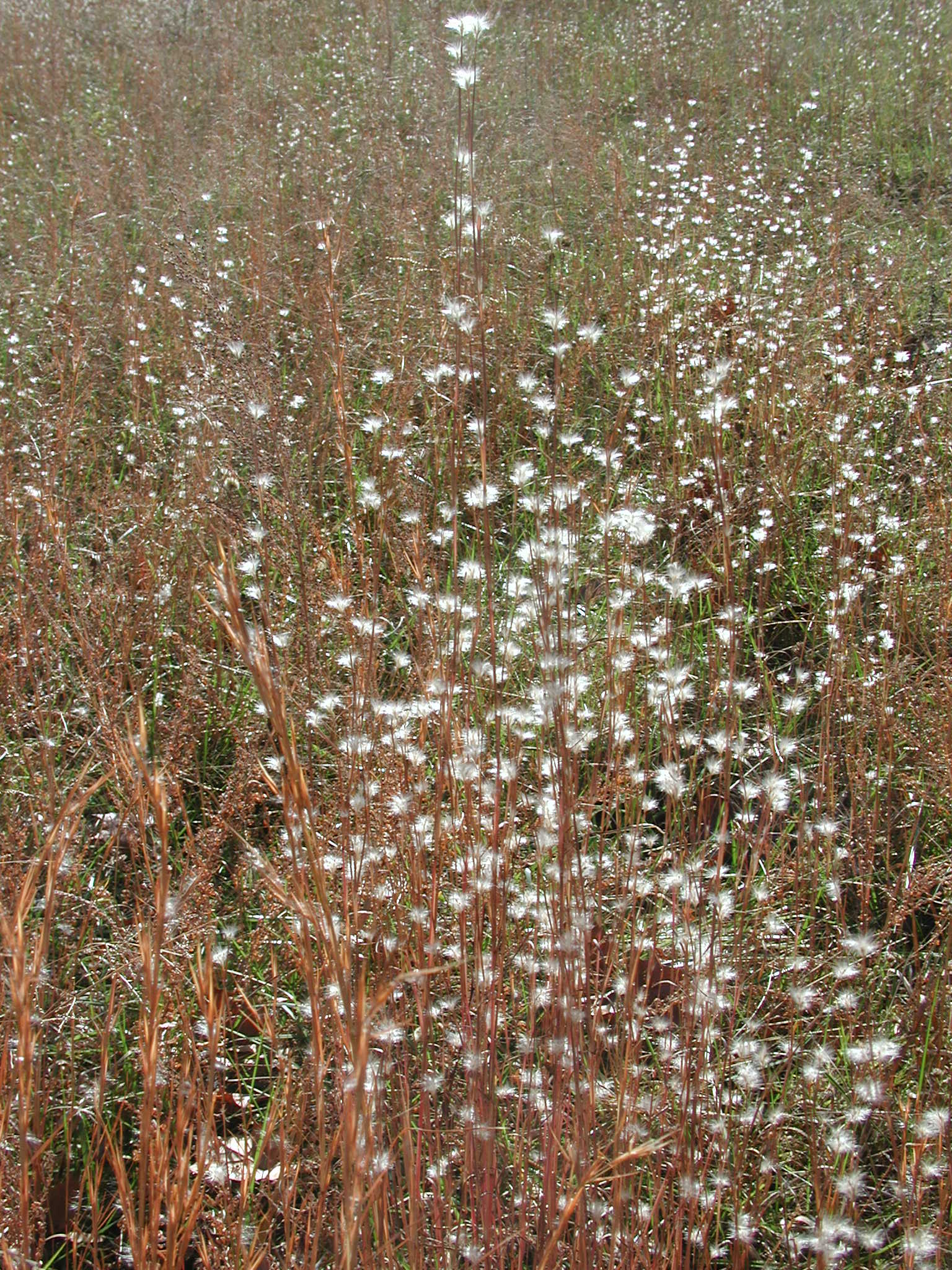Broomsedge
Contact
University of Arkansas System Division of Agriculture
Cooperative Extension Service
2301 S. University Ave.
Little Rock, AR 72204

Broomsedge
Driving the backroads of Arkansas in the fall and winter the roadside ditches and fields are often cloaked in the coppery glow of broomsedge. Fields of this native grass are beautiful in the slanted light of autumn but its presence hints at a sad state of affairs. Poverty. It thrives on poor, worn-out soil. Farmers trying to eke out a living on such soils often end up the same; poor, worn out and busted.
Broomsedge, Andropogon virginicus, is a true grass, not a sedge. It is one of over 100 species of “bluestem” grasses that have worldwide distribution. Big bluestem (A. gerardi) is an important forage grass of the Great Plains but broomsedge – also sometimes called “sage grass” – falls short of the mark as a forage grass. Cattle will eat it but for only a short period in the spring when the new leaves first emerge and there is nothing better available. Once the perennial, clump-forming, three-foot-tall, erect growing stems emerge in early summer, it is ignored by even deer.
On a tour of the South in 1853, Fredrick Law Olmstead – the most famous of all American landscape architects – described the worn-out farm fields of Virginia as; “a course, yellow, sandy soil, bearing scarce anything but pine trees and broom-sedge [sic] . . . sassafras bushes and blackberry-vines, which nature first sends to hide the nakedness of the impoverished earth.” Agricultural reformers of the 19th century used broomsedge as a talking point against the slash, burn, move-on approach used by many southern farmers of the period.
Broomsedge – so called because it was used in olden times to affix to handles to make brooms – is native to the southeastern states, ranging as far north as the Great Lakes. It is a pioneer species. A plant that invades disturbed places, abandoned fields, overgrazed pastures, cutover forests and cloaks the ground to hide the heavy hand of man.
It is suited to grow on many soil types but is usually seen in areas with low pH and poor fertility. Its presence often delineates well-managed agricultural land from the laissez-faire farmer lacking the will or resources to better manage the land. Soils lacking nitrogen and phosphorus are especially good sites to see broomsedge growing. In poorly fertilized fescue pastures broomsedge will compete with even the vigorous K-31 fescue, but if the pH is managed and fertility provided, the fescue will quickly crowd out the broomsedge.
The white, fluffy wind-borne seeds of broomsedge are released over a month or more in the fall. Seed germination is high and seedling survival is usually good in open-ground situations. As a pioneer species broomsedge does a fine job, perhaps aided by certain soil fungi. With the aid of a soil fungus, it can grow on mine tailing high in aluminum and is often seen on tailing piles of coal mines. Plants are also known to be allelopathic, meaning it produces organic compounds that retard the germination and growth of competing species of forbs. But broomsedge is shade intolerant and disappears as larger plants close the canopy above it. In open sites, half of the plants will have disappeared in four years; all in seven years if more desirable species are there to fill in the gap.
Broomsedge is not considered of much value to wildlife. Even deer shun it and they will eat about anything. In a Tennessee study looking at what bobwhite quail were eating, not a single broomsedge seed was found. But, in a freak 12-inch-deep Mississippi snowstorm, wildlife biologists did observe juncos and song sparrows feeding on broomsedge stems poking above the snow, apparently preferring the tiny seeds over nothing at all.
Broomsedge is now listed as an alien invader in many parts of the world, including Hawaii, Japan, Australia and all of Europe. Because all of these places have abused and misused lands, broomsedge can easily find a place to make itself at home.
We see what we want to see when we look at the world. Broomsedge is a wonderfully adapted plant for covering our planet’s scars but everywhere it is called a weed, an invader, a scourge. To gain our approval a plant must be well-mannered and controlled, and most of all, make us a tidy profit.
